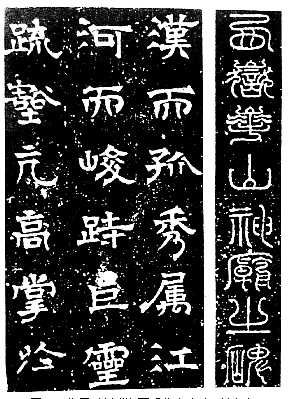The year of birth and death of Zhao Wenyuan is unknown. The courtesy name is Deben, a native of Nanyang Wan (now a native of Nanyang, Henan Province). There are biographies in "Book of Zhou" and "History of the North", but in these two books, because they avoid Tang taboos, they are all attributed to Zhao Wenshen. He once served as the Prime Minister's Fa Cao and joined the army. In the first year of Tianhe (AD 566), he eliminated the governor of Zhao Xing County for his meritorious service. Good at regular script and official script. At that time, many inscriptions were written by him, and he was ordered to compile a six-body calligraphy dictionary during the Western Wei Dynasty. "Shu Shu Fu" says: "Wenyuan and Xiaoyi (Zhao Xiaoyi) are the only ones who admire their predecessors. When they are respected as masters and disciples, they are as if they want to climb the dragon. They have the appearance of Song and Qi Dynasties, and they have no holes and a narrow mind."
The official script "Huayue Temple Stele" (also known as "Xiyue Huashan Temple Stele") is currently the only handwriting of Zhao Wenyuan handed down from generation to generation. This stele is erected in the Xiyue Temple in Huayin, Shaanxi Province. It is about 230 cm tall, 107 cm wide, 32 cm thick, and 50 cm high. It is a giant monument. There are 8 characters in seal script on the forehead of the stele: "The stele of Huashan Temple in Xiyue", and the inscription is written in official script. Emperor Wu of the Northern Zhou Dynasty, Yu Wenyong, ordered his ministers to erect this stele in the second year of Tianhe (567) to praise his father Yuwen Tai's restoration of Huayue Temple in the seventh year of Tiantong (541) in the Western Wei Dynasty. The inscription on this stele was written by Wan Niu Yu Jin and the book was written by Zhao Wenyuan, both of whom were the immediate choices of the Northern Zhou Dynasty.
The calligraphy style of "Huayue Temple Stele" belongs to the official script. The characteristics of Han Li's silkworm head and wild goose tail can be seen everywhere, and the knotted characters generally follow the principle of symmetry and balance of Han Li's knotted characters. However, in addition to this, there are several noteworthy features of this work: first, the use of brushwork has a strong decorative meaning, with exaggerated waves and decisive strokes; second, the mixture of seal script, official script, and regular script.
Predecessors have polarized positive and negative evaluations of such a strange combination as "Huashan Temple Stele". Some people think it is ugly and difficult to see. For example, Guo Zongchang criticized it in "History of Jinshi":
"Wenyuan was a doctor of calligraphy in Zhou Dynasty, and the elegance of calligraphy was the most important thing at that time... But the characters of "Huayue Stele" are ancient, crude and unsophisticated. It makes you sick at first sight, but it is famous for a while, why?"
Ye Changchi (1847-1917) commented in his "Yu Shi":
"... Although his books are dangerous and powerful, he has not strayed away from the vicious habits of Northern writers. Zheng Daozhao and his son are not considered to be among the holy sects of Youxia."
However, some people defend it and believe that the calligraphy style of "Huayue Temple Stele" has a unique and vigorous flavor. For example, Zhang Tingji's "Qingyi Pavilion Inscriptions and Postscripts" commented on it:
"There are mixed regular scripts and official scripts, and the Shanyin legacy is hard to find. However, among the inscriptions of Wei and Qi, it is unique and vigorous."
Yang Shoujing's (1839-1915) "Comments on the Stele" also gave a positive evaluation: "Wen Yuan had a very famous book title in Zhou Dynasty. It is a stele. The predecessors derided it as a bad letter and a sinner of dividing books. I said that it is based on dividing books. , The sincerity is not good, but if it were written as a real book based on its meaning, it would be extremely high-end."
Regardless of personal likes and dislikes, "Huayue Temple Stele" is very important in the history of calligraphy. Its highly decorative brushstrokes were at the end of the ancient "stone calligraphy" tradition in the Central Plains since the Eastern Han Dynasty. The mixture of seal script and regular script in official scripts was a new look of stele calligraphy in the Northern Dynasties during this period.
The first striking stylistic feature of "Huayue Temple Stele" is its angular brushwork. The strokes and strokes are both square and cut, and the overall look is rugged and sharp. Judging from the traditional calligraphy aesthetics that emphasize virtuality and use of brushes, these strokes are artificial and unnatural. Rather than calling them "calligraphy", it is better to call them artistic calligraphy. If we further trace the development of calligraphy history, we can find that the special style of "Huayue Temple Stele" has a long historical origin and is not Zhao Wenyuan's personal creation. It is similar to the eight-point official script of the Three Kingdoms and Western Jin Dynasties, and it inherits the ancient "stone inscription script" of the Central Plains since the late Eastern Han Dynasty.
After entering the Sui Dynasty, none of his writings were recorded, or he was in his twilight years and his time was short, and he only wrote about the two kings in passing. (Refer to Lu Huiwen's "Jiangzuo Romance and the Ancient Methods of the Central Plains" in "Youth Calligraphy (Youth Edition)" Issue 5, 2005)

Zhao Wenyuan's "Huayue Temple Stele" (detail) 567








